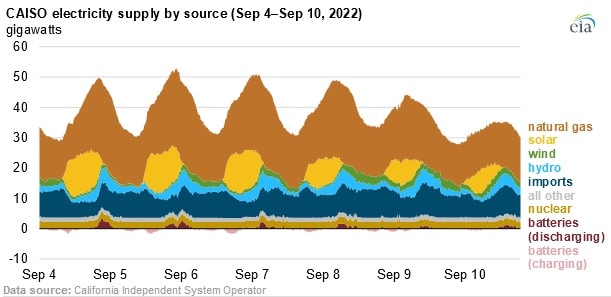California Grid Operator Reports Record Electricity Demand Amid Heat Wave

Natural gas contributed nearly half of California’s electricity generation mix to meet peak demand during an extreme heat wave in early September, according to a Sept. 21 report from the U.S. Energy Information Administration. The heat wave during the week of Sept. 4 led to record demand for electricity, amid elevated air conditioning use. Moreover, on Sept.6 a new record was set in the California Independent System Operator (CAISO) territory.
According to CAISO for brief periods during the week of Sept. 4, natural gas accounted for 60 percent of the generation mix, compared with 32 percent for the same period in the previous year. California usually employs a blend of solar, wind, imports, hydroelectric, and natural gas sources for electricity production. The particular mix depends on the hour of the day, the accessibility of other energy sources, and the price power plants are willing to sell their power generation to the electricity grid.
The electricity mix normally relies marginally more on natural gas during the evening hours from 6 to 9 pm, during peak demand and when solar and wind generation declines, due to weather conditions. During the week of Sept. 4 natural gas accounted for nearly 50 percent of the generation mix in CAISO, whilst nuclear, solar, wind, batters and other generation sources declined to a 24 percent share.
In California, natural gas plants are consistently the last supply source to fulfil demand because they can be turned on once the sun sets in the evening when demand for cooling rises. When demand increases to record high levels, infrequently used resources that are less efficient and more expensive – natural gas units – are considered necessary to meet demand. Natural gas prices in the U.S. have reached unprecedented levels in 2022, on the back of both firm domestic demand and export demand, as a result using natural gas in the generation mix has become an expensive source of generating electricity.
CAISO avoided issuing outages by advising customers to save energy for 10 consecutive days through the heat wave, as homes and businesses in the drought-ridden region turned up their air conditioning demand.
In light of the electricity reliability concerns, California recently enacted legislation to extend the operations at Diablo Canyonits, the state’s last nuclear power plant, until 2029 and 2030. The legislation authorizes a $1.4 billion loan from the general fund to Pacific Gas and Electric, which operates the plant, to support the reactor unit relicensing costs.
EnerKnol Pulses like this one are powered by the EnerKnol Platform—the first comprehensive database for real-time energy policy tracking. Sign up for a free trial below for access to key regulatory data and deep industry insights across the energy spectrum.
ACCESS FREE TRIAL